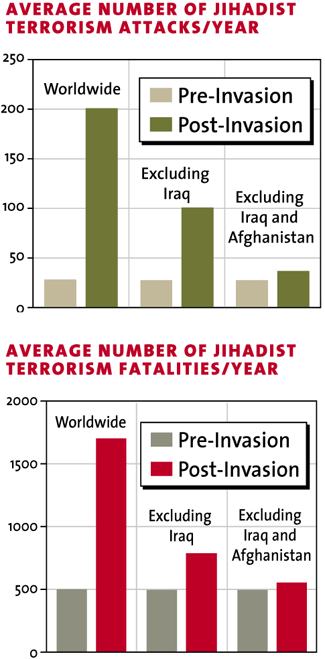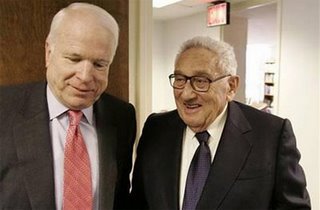Iraq Effect: Bad Social Science
Peter Bergen and Paul Cruickshank argue in the latest Mother Jones that the Iraq War has led to a seven-fold increase in the number of fatal jihadist terrorist attacks.
Their study compared two time periods: “September 12, 2001, to March 20, 2003 (the day of the Iraq invasion), and March 21, 2003, to September 30, 2006” and included attacks by “Sunni extremist groups affiliated with or sympathetic to the ideology of Al Qaeda” but excluded those by Palestinian groups. Their findings:
The rate of terrorist attacks around the world by jihadist groups and the rate of fatalities in those attacks increased dramatically after the invasion of Iraq. Globally there was a 607 percent rise in the average yearly incidence of attacks (28.3 attacks per year before and 199.8 after) and a 237 percent rise in the average fatality rate (from 501 to 1,689 deaths per year). A large part of this rise occurred in Iraq, which accounts for fully half of the global total of jihadist terrorist attacks in the post-Iraq War period. But even excluding Iraq, the average yearly number of jihadist terrorist attacks and resulting fatalities still rose sharply around the world by 265 percent and 58 percent respectively.
Including the terrorist attacks that are perpetrated within Iraq by anti-government forces simply makes no sense given the mission at hand; one might as well include the massacres in Darfur.
Of course, just because jihadist terrorism has risen in the period after the invasion of Iraq, it does not follow that events in Iraq itself caused the change. For example, a rise in attacks in the Kashmir conflict and the Chechen separatist war against Russian forces may have nothing to do with the war in Iraq.
Quite right. Yet, stunningly, those figures–and those in Iraq and Afghanstan–are being included in the hyperbole about the sevenfold increase.
But the most direct test of The Iraq Effect–whether the United States and its allies have suffered more jihadist terrorism after the invasion than before–shows that the rate of jihadist attacks on Western interests and citizens around the world (outside of Afghanistan and Iraq) has risen by a quarter, from 7.2 to 9 a year, while the yearly fatality rate in these attacks has increased by 4 percent from 191 to 198.
 So, essentially, we’re comparing two very short periods of time and trying to draw statistical meaning from tiny variations? Surely, a difference of 1.8 attacks and 7 fatalities a year could be found in other similar periods. Indeed, if one looked at the two to three year period before and including the 9/11 attacks, you’d likely find a greater number of attacks on Western targets and certainly a higher casualty rate.
So, essentially, we’re comparing two very short periods of time and trying to draw statistical meaning from tiny variations? Surely, a difference of 1.8 attacks and 7 fatalities a year could be found in other similar periods. Indeed, if one looked at the two to three year period before and including the 9/11 attacks, you’d likely find a greater number of attacks on Western targets and certainly a higher casualty rate.
The RAND MIPT Terror Knowledge Base that Bergen and Cruickshank use in their study is a bit cumbersome because of the incredible number of Hamas and PLO attacks in Israel (which are excluded from the count) and those taking place within Iraq and Afghanistan (which should have been) and, oddly, the piece does not include a breakout table. It’s difficult, then, to compare incidents. Presumably, the London and Madrid bombings make up the lion’s share of the increased fatalities.
The hype of the “War Has Increased Terrorism Sevenfold Worldwide” is simply unsupported from the evidence and it has been made worse by the slight-of-hand of counting the violence in multiple ongoing wars that the authors themselves admit are not reasonable measures of “the Iraq Effect.” Laughably, any increases in terrorism, even in places like Chechna and the India-Pakistan mess, are linked to the war (because, you know, it increased the motivation of Pakistani Muslims to kill Indians and “radicalized” them) while decreases in the numbers, as in much of Southeast Asia, is attributed to “the successful crackdown by local authorities on jihadist groups and their growing unpopularity with the general population.”
The authors do, however, make a strong case later in the piece that the war has inflamed Muslim public opinion around the world and that there has been an increase in the number of young would-be jihadists heading to terrorist training camps. I don’t doubt that these are happening. It is, however, noteworthy that al Qaeda was a growing force that had perpetrated numerous attacks on United States and other Western targets in the decade prior to the invasion of Iraq. It’s impossible to know how many attacks and fatalities there would have been absent that invasion. Surely, the thirty month post-9/11 lull during which their primary base of operations was being destroyed and assuming that was the high point will not answer that question.






I cannot understand your title. Neither the original post nor your comment has anything to do with science.
The reason they didn’t include Palestine was because the attacks are way down from pre-war. Would have completely messed up the result they wanted to achieve.
7 fold increase…hmmm…I wonder where they talk about US troops killing of terrorists has increased one hundred fold! We kill terrorists by the score everyday in Iraq. This is a good thing in my opinion. Terrorists that American soldiers kill are potential murderers here in the USA.
But more importantly, since MOTHER Jones mag seeks to reason that the US war in Iraq creates terrorists, where did the ones who killed thousands on US soil on 9/11 come from. Hmmm…I wonder how liberals would answer THAT question!